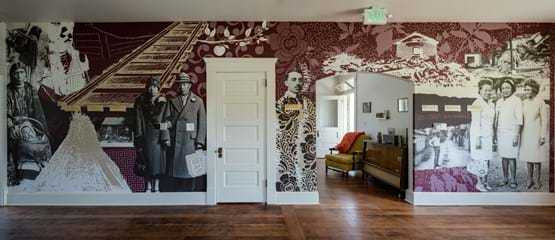
With ongoing permanent and rotating exhibitions, the Erma Hayman House hosts a variety of opportunities for visitors to learn about the story of Erma Hayman, her house, and the River Street Neighborhood.
WHAT'S ON

Bernadette Nyirabariyanga. Image courtesy Gracieux Baraka.
Afro Blue: An Ode, Celebration, and Meditation
September 23, 2023 - June 29, 2024
In honor of Black History Month in February 2023, a collaborative exhibition project was proposed to showcase the rich cultural heritage of the Black community in Idaho. The Boise City Department of Arts & History partnered with the Idaho Black Community Alliance (IBCA) to bring this vision to life.
As part of the celebration, the IBCA organized a spectacular Black Excellence Gala, featuring a showcase of fashion, hairstyles, and performances that beautifully captured pivotal moments in the intricate background and history of the Black community in Idaho.
The Black Excellence Gala delved into the exploration of Black History, intertwining its narrative with the vibrant tapestry of Black culture. The event aimed to cultivate an appreciation for and celebration of this cultural legacy, contributing not only to the diversity of our global culture but also fostering greater cross-cultural understanding.
In a supportive role for the IBCA's event, Arts & History collaborated with visual artist and photographer, Gracieux Baraka. Baraka was tasked with skillfully capturing the essence of each model and reflecting the aesthetic and purpose of each era represented in the celebration.
This impressive body of work, commissioned as part of the Boise Visual Chronicle, now resides in the permanent collection of the City of Boise. The Boise Visual Chronicle strives to preserve and showcase the multifaceted experience of life in Boise through the medium of visual art.
About Afro Blue by Gracieux Baraka.
PAST EXHIBITIONS

Image courtesy Gabe Border.
Threads of Land: A History of the Site the Erma Hayman House Resides On
September 22, 2022 - September 23, 2023
In partnership with Stephanie Inman
This mural by Boise-based artist Stephane Inman interprets, through seven key moments, the story of the land on which the Erma Hayman House resides, from the region's Indigenous People to Mrs. Hayman's time onsite all the way through the urban renewal period of the 1960s and 70s, which significantly altered the neighborhood’s historic footprint.
